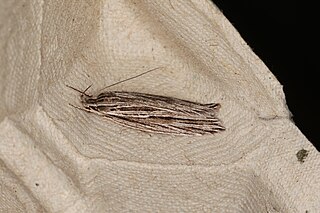Related Research Articles
Petasactis is a genus of moths belonging to the family Tineidae. It contains only one species, Petasactis technica, which is endemic to New Zealand. This species has not been collected since prior to 1888. It is classified as "Data Deficient" by the Department of Conservation.
Epermenia leucomantis is a moth in the family Epermeniidae. It was described by Edward Meyrick in 1917. It is found in Assam, India.
Zelosyne olga is a moth in the family Gelechiidae. It was described by Edward Meyrick in 1915. It is found in Guyana.
Thiotricha janitrix is a moth of the family Gelechiidae. It was described by Edward Meyrick in 1912. It is found in the Bengal region of what was British India.
Scythropiodes leucostola is a moth in the family Lecithoceridae. It was described by Edward Meyrick in 1921. It is found in Japan and Korea.
Antaeotricha impedita is a moth of the family Depressariidae. It was described by Edward Meyrick in 1915. It is found in Peru.
Orphnolechia is a genus of moths in the subfamily Stenomatinae.
Catoryctis sciastis is a moth in the family Xyloryctidae. It was described by Edward Meyrick in 1915. It is found in Australia, where it has been recorded from the Australian Capital Territory, New South Wales and Victoria.

Leistarcha amphigramma is a moth in the family Xyloryctidae. It was described by Edward Meyrick in 1915. It is found in Australia, where it has been recorded from the Australian Capital Territory and New South Wales.
Xylorycta maeandria is a moth in the family Xyloryctidae. It was described by Edward Meyrick in 1915. It is found in Australia, where it has been recorded from New South Wales.
Loboptila cyphoma is a moth in the family Depressariidae. It was described by Edward Meyrick in 1915. It is found in Australia, where it has been recorded from Queensland.
Odites scribaria is a moth in the family Depressariidae. It was described by Edward Meyrick in 1915. It is found on the Solomon Islands and New Guinea.
Odites fructuosa is a moth in the family Depressariidae. It was described by Edward Meyrick in 1915. It is found on the Comoros, where it has been recorded from Mayotte.
Antaeotricha paracrypta is a moth in the family Depressariidae. It was described by Edward Meyrick in 1915. It is found in Guyana.
Antaeotricha tinactis is a moth in the family Depressariidae. It was described by Edward Meyrick in 1915. It is found in Guyana.
Orphnolechia crypsiphragma is a moth in the family Depressariidae. It was described by Edward Meyrick in 1909. It is found in Bolivia.
Chlamydastis melanonca is a moth in the family Depressariidae. It was described by Edward Meyrick in 1915. It is found in Guyana.
Chlamydastis paradromis is a moth in the family Depressariidae. It was described by Edward Meyrick in 1915. It is found in Colombia.
Tinea sequens is a moth of the family Tineidae first described by Edward Meyrick in 1919. It is known from Guyana.
Crypsitricha roseata is a species of moth in the family Tineidae. It was described by Edward Meyrick in 1913. This species is endemic to New Zealand. The type locality of this species is the suburb of Wadestown, in Wellington.
References
- ↑ Savela, Markku, ed. (February 8, 2015). "Orphnolechia neastra (Meyrick, 1915)". Lepidoptera and Some Other Life Forms. Retrieved September 8, 2020.
- ↑ Meyrick, Edward (1912–1916). Exotic Microlepidoptera. 1 (13): 412.
| This article on a moth of the subfamily Stenomatinae is a stub. You can help Wikipedia by expanding it. |